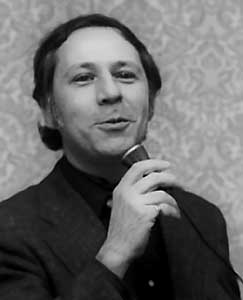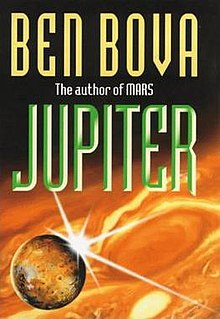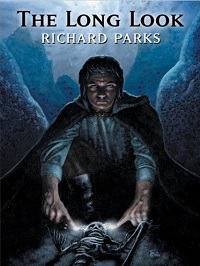Plot summary
Mance was the chief visionary and engineer behind the skytower, a super space elevator which ran from Ecuador all the way into low Earth orbit. When religious fundamentalists and agents of the scheming Yamagata Corporation sabotage the skytower, however, millions are killed; Mance is faced with his own guilt for the tragedy and sees himself as ostensibly responsible. He is arrested and put on trial. Things turn out even worse for Mance when his friends, bioengineer Victor Molina and Rev. Elliott Danvers, abandon him, and he is exiled to a life of hard work and misery in the Asteroid Belt, far from his beloved wife Lara—upon whom the double-crossing Victor Molina had always harbored designs. For a time, he escapes his fate in the Belt by being inducted into the crew of an ore hauler, where for a while he contemplates his life and comes to the conclusion that he was set up.
Ultimately he falls for the captain's beautiful young daughter Addie. When the same forces responsible for the destruction of the skytower destroy the freighter, Mance manages to survive by having been outside, tethered to the ship as punishment from the captain for having been caught with his daughter. Rescued against all odds, Mance is brought to the moon to recuperate, where he is able to assume the identity of the ship's late first officer, Dante Alexios, by undergoing extensive nano reconstruction to make him appear outwardly identical to Dante Alexios.
With his new persona, Mance/Dante leads a successful engineering career, which empowers him to plot his revenge against those whom he blames for his downfall: the simple but good-natured New Morality clergyman Elliott Danvers, and Molina (who has since married Lara with whom he has a child) and the Yamagata Corporation. Mance lures the three to Mercury where he manages to infiltrate the Yamagata operations and cause financially ruinous delays to their Mercurian project by planting Martian rock samples containing organic compounds there. These he allows to be discovered by Molina, who believes them to be authentically Mercurian and heralds them as a great discovery. Finally, he frames the Rev. Danvers for the trickery in order to also ruin his career, which succeeds flawlessly—to the extent that Danvers takes his own life. Yet things go awry for Mance when he confesses to Lara that it was he who set up Molina for the fall. However justified it may have been, Lara cannot accept it, nor can she return to Mance/Dante. Crushed, Bracknell turns the focus of his ruined life to consummating his final revenge on the leader of the Yamagata Corporation himself. However, it is in trying to slowly and agonizingly destroy the life of Yamagata, by exposing him to the brutal elements of the planet Mercury for a prolonged period of time, that Mance perhaps finally realizes that revenge has ruined him, and feels regret upon hearing of Danvers' fate. Furthermore, he had caught the wrong Yamagata; it was the son of the billionaire industrialist who'd been culpable in the skytower disaster.
In the end, both Yamagata and Bracknell perish in the Mercurian wastes, but the reader is led to believe, through his last will and testament, that Bracknell in his final moments beat his demons and became human again by taping a confession of his schemes while waiting to die. At the same time, Yamagata, who was gladly willing to die if only to protect his son, tapes a message to his son, imploring him to continue his true work in taking humanity to the stars in the near future.

Benjamin William Bova was an American writer and editor. During a writing career of 60 years, he was the author of more than 120 works of science fact and fiction, six-time winner of the Hugo Award, an editor of Analog Science Fiction and Fact, an editorial director of Omni; he was also president of both the National Space Society and the Science Fiction Writers of America.

Project Mercury was the first human spaceflight program of the United States, running from 1958 through 1963. An early highlight of the Space Race, its goal was to put a man into Earth orbit and return him safely, ideally before the Soviet Union. Taken over from the US Air Force by the newly created civilian space agency NASA, it conducted 20 uncrewed developmental flights, and six successful flights by astronauts. The program, which took its name from Roman mythology, cost $2.38 billion. The astronauts were collectively known as the "Mercury Seven", and each spacecraft was given a name ending with a "7" by its pilot.

A space elevator, also referred to as a space bridge, star ladder, and orbital lift, is a proposed type of planet-to-space transportation system, often depicted in science fiction. The main component would be a cable anchored to the surface and extending into space. The design would permit vehicles to travel up the cable from a planetary surface, such as the Earth's, directly into orbit, without the use of large rockets. An Earth-based space elevator could not feasibly be simply a tall tower supported from below, due to the immense weight - instead it would consist of a cable with one end attached to the surface near the equator and the other end attached to a counterweight in space beyond geostationary orbit. The competing forces of gravity, which is stronger at the lower end, and the upward centrifugal force, which is stronger at the upper end, would result in the cable being held up, under tension, and stationary over a single position on Earth. With the tether deployed, climbers could repeatedly climb up and down the tether by mechanical means, releasing their cargo to and from orbit.

The Count of Monte Cristo is an adventure novel written by French author Alexandre Dumas (père) completed in 1844. It is one of the author's more popular works, along with The Three Musketeers. Like many of his novels, it was expanded from plot outlines suggested by his collaborating ghostwriter Auguste Maquet.

Edmond Dantès is a title character and the protagonist of Alexandre Dumas's 1844 adventure novel The Count of Monte Cristo. Within the story's narrative, Dantès is an intelligent, honest and loving man who turns bitter and vengeful after he is framed for a crime he did not commit. When Dantès finds himself free and enormously wealthy, he takes it upon himself to reward those who have helped him in his plight and punish those responsible for his years of suffering. He is known by the aliases The Count of Monte Cristo, Sinbad the Sailor, Abbé Busoni and Lord Wilmore.

Chasm City is a 2001 science fiction novel by British writer Alastair Reynolds, set in the Revelation Space universe. It deals with themes of identity, memory, and immortality, and many of its scenes are concerned primarily with describing the unusual societal and physical structure of the titular city, a major nexus of Reynolds's universe. It won the 2002 British Science Fiction Association award.

A megastructure is a very large artificial object, although the limits of precisely how large vary considerably. Some apply the term to any especially large or tall building. Some sources define a megastructure as an enormous self-supporting artificial construct. The products of megascale engineering or astroengineering are megastructures. The lower bound of megastructural engineering might be considered any structure that has any single dimension 1 megameter (1000 km) in length.

Lucky Starr and the Big Sun of Mercury is the fourth novel in the Lucky Starr series, six juvenile science fiction novels by Isaac Asimov that originally appeared under the pseudonym Paul French. The novel was first published by Doubleday & Company in March 1956. Since 1972, reprints have included a foreword by Asimov explaining that advancing knowledge of conditions on Mercury has rendered some of the novel's descriptions of that world inaccurate.

An orbital ring is a concept of an artificial ring placed around a body and set rotating at such a rate that the apparent centrifugal force is large enough to counteract the force of gravity. For the Earth, the required speed is on the order of 10 km/sec, compared to a typical low Earth orbit velocity of 8 km/sec. The structure is intended to be used as a space station or as a planetary vehicle for very high-speed transportation or space launch.

Space Cases is a Canadian science fiction television series that aired on Nickelodeon for two seasons. Created by Peter David and Bill Mumy, it premiered on March 2, 1996 and ended on January 27, 1997 with reruns until 1998. It aired for a time on Nickelodeon's Saturday night block of shows known as SNICK, and on Nickelodeon UK, with reruns on Family and TVOntario in Canada. An episode aired on TeenNick in the US as part of its The '90s Are All That block on the night of October 14, 2011 for the block's U Pick with Stick line-up, and again on December 27, 2011 for Party Like It's the '90s. Space Cases returned once again on the night of January 1, 2016 on TeenNick during the new The Splat programming block but has not aired since; the first four episodes of Season One were aired. The show's premise revolves around a group of misfit students and two adults who are stranded far from home aboard an alien ship. Their attempts at journeying back see many dangerous adventures and controversies, with some occasionally more mature themes.

Eric John Stark is a character created by the science fiction author Leigh Brackett. Stark is the hero of a series of pulp adventures set in a time when the Solar System has been colonized. His origin-story shares some characteristics with feral characters such as Mowgli and Tarzan; his adventures take place in the shared space opera planets of 1940s and 1950s science fiction.

Higher Education is a 1996 science fiction novel by Charles Sheffield and Jerry Pournelle. It first appeared in the February to May 1986 issues of Analog Science Fiction and Fact The book is part of the Jupiter series and was first published in book form by Tor Books in June 1986.
This is a list of occurrences of space elevators in fiction. Some depictions were made before the space elevator concept became fully established.
The Grand Tour is a series of novels written by American science fiction author Ben Bova.

Mysterious Island is a 1951 American 15-chapter movie serial from Columbia Pictures, the studio's 46th, that stars Richard Crane, Marshall Reed, Karen Randle, and Ralph Hodges. It is an adaptation of Jules Verne's 1874 novel, The Mysterious Island. As in the original story, which was Verne's follow-up to Twenty Thousand Leagues Under the Sea, this serial is set in 1865. However, Columbia's screenwriters added alien Mercurians as an additional set of villains. The serial has been labeled a space opera version of Verne's novel.
"Ender's Game" is a science fiction novelette by American writer Orson Scott Card. It first appeared in the August 1977 issue of Analog magazine and was later expanded into the 1985 novel Ender's Game. Although the foundation of the Ender's Game series, the novelette is not properly part of the Ender's Game universe, as there are many discrepancies in continuity.

Non-rocket spacelaunch refers to concepts for launch into space where much of the speed and altitude needed to achieve orbit is provided by a propulsion technique that is not subject to the limits of the rocket equation. A number of alternatives to rockets have been proposed. In some systems, such as a combination launch system, skyhook, rocket sled launch, rockoon, or air launch, a portion of the total delta-v may be provided, either directly or indirectly, by using rocket propulsion.

Jupiter is a science fiction novel by American writer Ben Bova. This novel is part of the Grand Tour series of novels. It was first published in 2000.

Titan is a science fiction novel written by Ben Bova as part of the Grand Tour novel series. It directly follows the novel Saturn, in which the space habitat Goddard has finished its two-year journey from Earth, and has settled into the orbit of Saturn. The book won the 2007 John W. Campbell Memorial Award. It was first published in February 2001, by Hodder & Stoughton in the UK and later by Tor Books in the US.

The Long Look is a fantasy novel by Richard Parks, both his first novel and the first volume in his series The Laws of Power. It was first published in hardcover by Five Star in September 2008. It has appeared as an ebook in 2011 and a trade paperback in October 2018. The book placed twelfth in the 2009 Locus Poll Award for Best First Novel.
















